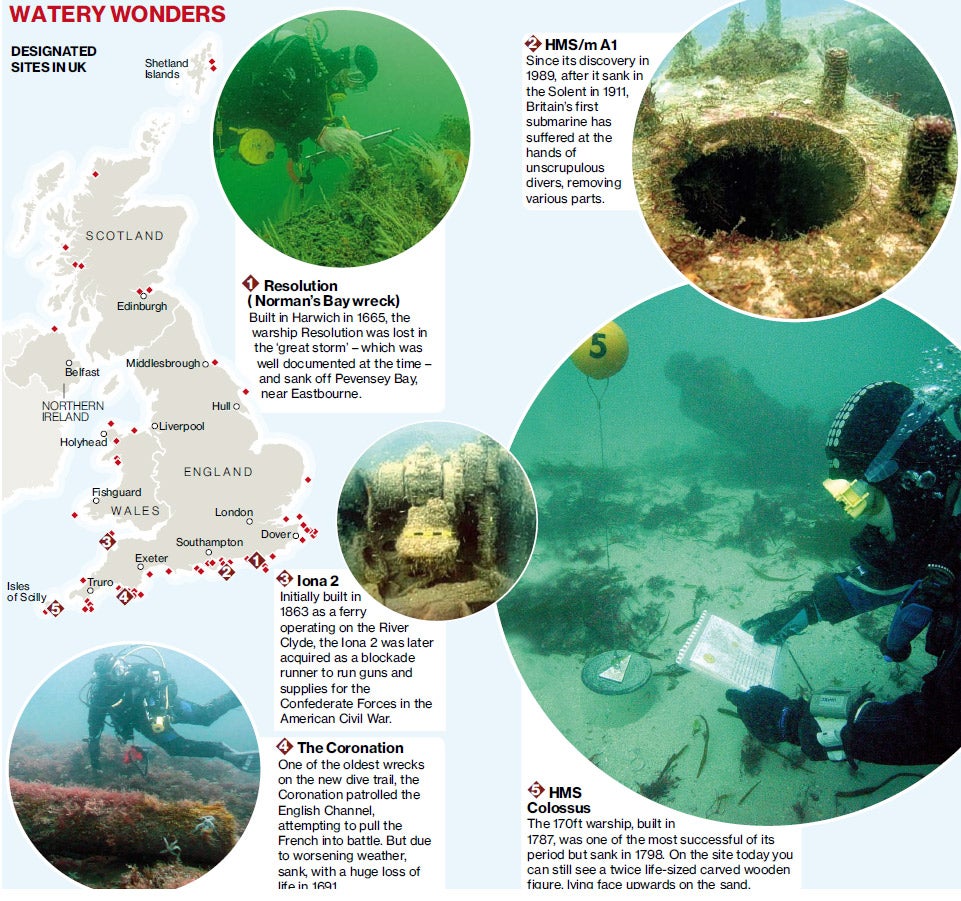Deep blue yonder: UK tourist trail extends all the way to seabed
Waterproof guidebooks and underwater signposts to help people explore Britain’s most secluded heritage sites

One of the world’s largest underwater tourist trails is being pioneered off the south coast of England, as the conservation group English Heritage prepares to create more than a dozen seabed diving attractions.
Click image above to enlarge graphic
By 2018, scuba divers will be able to explore wrecks dating from the 17th to mid-20th centuries, using underwater signposts and waterproof guide books. So far, three sites are available and in the next few months a fourth – Britain’s first submarine – will be included. The organisation hopes the move will encourage more people to explore the nation’s rich underwater heritage.
Currently, divers can visit HMS Colossus, a Georgian warship which sank off the Isles of Scilly in 1798, the Coronation, built in 1685, which was lost off Penlee Point, near Plymouth, in 1691, and the Resolution, commonly known as the “Norman’s Bay Wreck”, which sank during the great storm of 1703 near Beachy Head, East Sussex.
English Heritage says many more sites around the UK will be added to the trail over the next few years. Sixty- one sites currently designated under the Protection of Wrecks Act 1973, but this is believed to be only a tiny fraction of the total. “I see it as exactly the same as visiting one of our land-based properties or monuments,” said Alison James, a marine archaeologist at English Heritage.
“This is just a different part of the historic environment. You’ll get an underwater booklet which guides you around the seabed where there are numbered stations. You’ll then see what you’re looking at and a compass bearing will be given, pointing to the next site. Even as a maritime archaeologist, looking at what you see on the seabed isn’t always obvious, so this does really help interpret the site for people.”
At the HMS Colossus site, divers can see timbers, eight cannon and several muskets preserved on the sea floor. The 74-gun warship, built in 1787, was carrying soldiers wounded at the Battle of the Nile home to England when, after sheltering from a gale, its anchor cable snapped and it ran aground off Samson, one of the uninhabited Scilly isles. Despite the perilous situation in which the vessel found itself, only one crew member died during a huge rescue operation that saw 600 men taken to safety before the ship broke up.
Later this summer, divers will also be able to visit HMS A1, the first British-designed and built submarine used by the Royal Navy. The unfortunate boat sank twice in its career – first in March 1904, when the crew of 11 drowned after the sub collided with a mail ship in the Solent and sank in only 39ft (12m) of water. As a consequence, all subsequent navy submarines were equipped with watertight hatches on their conning towers.
After an accidental petrol explosion in August 1910, the A1 was used for unmanned missions – but sank again in 1911. It was not until 1989 that the wreck was rediscovered at Bracklesham Bay by a fisherman, who accidentally snagged it with his net.
Next year, the paddle-steamer Iona 2, which sank off Lundy Island in the Bristol Channel, will be added to the English Heritage scheme. The vessel started life as a ferry on the Clyde, and was lost in 1864 on its way to America, where it was to begin a new role as a Confederate blockade-runner during the American Civil War.
Unlicensed visits to any of the sites are illegal and divers must obtain a license from English Heritage before visiting. Specially contracted charter boats will be provided for each wreck. Divers are not allowed to take or move anything on the remains, but they are allowed to take photographs and will be encouraged to contribute a short report about what they see, which often results in unusual items being uncovered.
“People sometimes dismiss British waters for diving but we’ve got so much that is so rich,” said Jane Maddocks, an underwater heritage adviser with the British Sub-Aqua Club. “This new scheme is an excellent idea because there are an awful lot of divers out there who would really like to dive on a historically special wreck.
“Now they can do it and can actually understand what it is they’re looking at. Visitors to these sites will be able to see things which many people can’t – it’s very special, individual contact with our heritage.”
Join our commenting forum
Join thought-provoking conversations, follow other Independent readers and see their replies
Comments